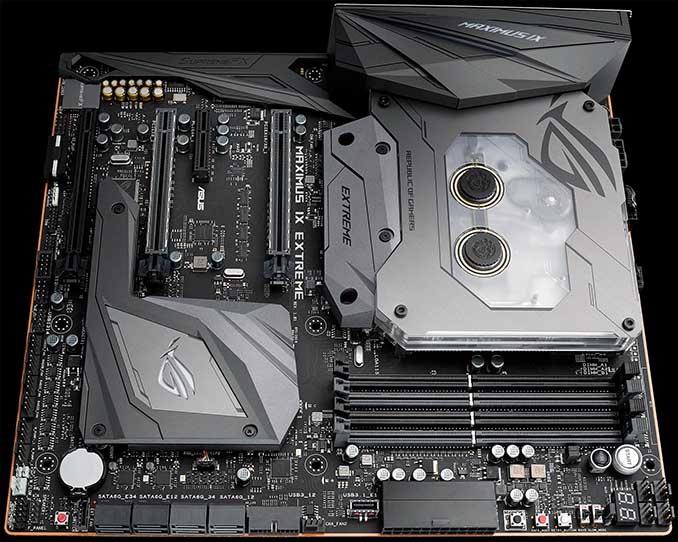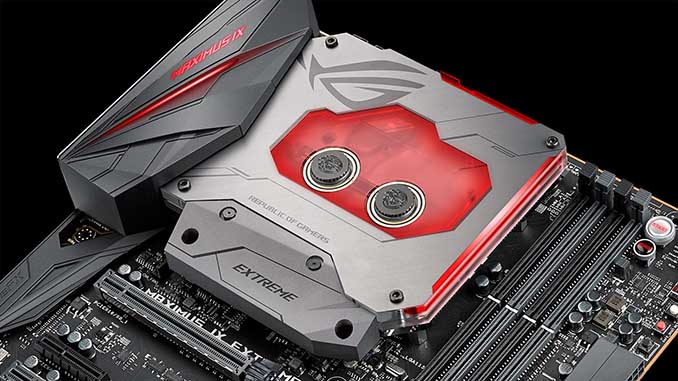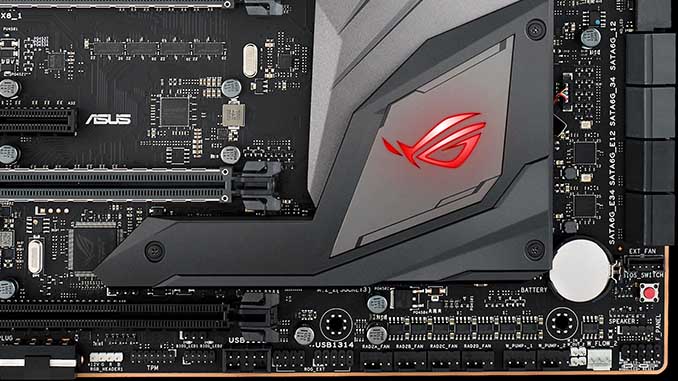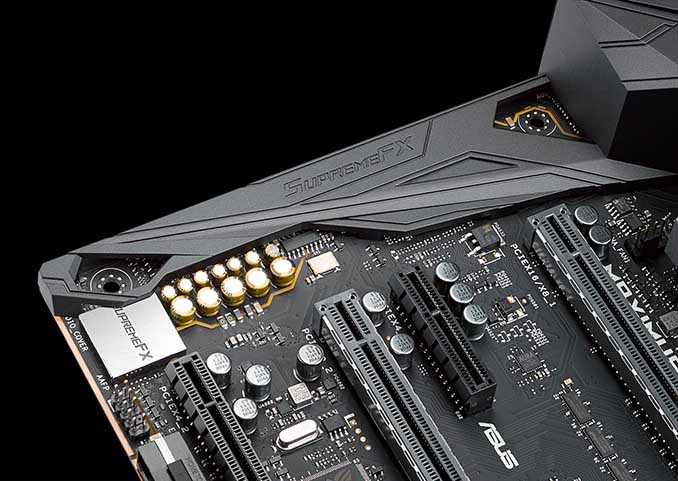ASUS Maximus IX Extreme Z270 Motherboard Now Available: $629 with Water Block
by Patrick MacMillan on May 4, 2017 1:00 PM EST
First unveiled at CES 2017, and launched by ASUS back in early March, the availability of the flagship Republic of Gamers (ROG) Z270 motherboard has thus far been limited to Newegg in North America. That changes today with the announcement that the Maximus IX Extreme is now widely available at leading resellers in both Canada and the United States.
Built for gaming and liquid cooling enthusiasts, the Maximus IX Extreme represents the pinnacle of ASUS' engineering expertise. ASUS has also collaborated with Bitspower in order to develop the factory-installed monoblock water cooling solution that is clearly the model's most distinguishing feature over other motherboards. The monoblock is so large that it is likely the main factor behind this model's price.
Designed to cool the CPU and the associated power delivery components, this monoblock incorporates flow rate, water leak, and inlet/outlet temperature sensors, all of which can be monitored and controlled from within the UEFI or the Fan Xpert IV utility. There is also ubiquitous RGB LED lighting built-in, which can be controlled by the AURA utility along with the LEDs integrated into the I/O cover, PCH heatsink, and any light strip attached to the 5050 RGB header. Speaking of headers, this motherboard has a lot of them. There are 12 fan headers, which includes 8 radiator fan headers and 2 water pump headers, and a number of additional flow rate and temperature sensor headers. Overall, this should not only negate the need for any additional fan controllers, but also reduce wiring complexity. All of these headers can be fully configured from within the UEFI or Fan Xpert IV utility.
There is also a separate heatsink included to cool the topmost M.2 drive. While it is not part of the monoblock, it does make contact with it and thus should receive some level of passive cooling. Not to be ignored, the secondary M.2 drive can be cooled with the M.2 cover that is integrated into the PCH heatsink. Both of these M.2 connectors support SATA and PCI-E 3.0 x4 NVMe SSDs, as well as Intel Optane Memory, but only the secondary connector supports longer 22110-type drives. The remaining drive storage needs are handled by eight SATA 6Gb/s ports.
In addition, the mainboard supports eight USB 3.0 ports (six rear, one header), four USB 2.0 ports (via two headers), one USB 3.1 type-A port, one USB 3.1 type-C port that supports Thunderbolt 3, and a rare USB 3.1 front-panel connector. Rounding out the connectivity is one gigabit LAN port powered by an Intel I219-V controller, onboard 2x2 802.11ac Wi-Fi with MU-MIMO that is based on Qualcomm Atheros QCA6174A chip, as well as HDMI 1.4 and DisplayPort 1.2 video outputs.
Since this is a high-end gamer-oriented motherboard, it is no surprise to see ROG SupremeFX onboard audio. This 8-channel audio solution is designed around the Realtek ALC1220A codec, but also features a Texas Instruments RC4580 op-amp, ESS ES9023P digital-to-analog converter (DAC) for the front-panel output, shielded audio circuits, impedance sensing for the front and rear headphone outputs, and color-coded and LED-illuminated 3.5mm audio connectors.
Given the pedigree of the Extreme model name, overclockers have not been overlooked either. There is a plethora of ASUS-specific features that are designed with overclocking in mind, such as the ProbeIT voltage read points, Q_Code LED, an LN2 Mode jumper, a Slow Mode Switch, an RSVD switch, a ReTry button, a Safe Boot button, a MemOK! button, a DRAM channel jumper, and the ROG Extension connector. There are also diagnostic LEDs throughout the motherboard.
Last but not least, the board features a standard complement of four DDR4 slots (which support overclocked memory speeds up to DDR4-4133), two strengthened PCIe x16 slots for graphics purposes (PCIe 3.0 x16 or x8/x8), one PCIe 3.0 x4 slot from the chipset, and one full length PCIe slot that operates at PCIe 3.0 x4. These last two slots get their bandwidth from the PCH, and there are SATA limitations that you need to research if you plan to use the mechanical PCIe x4 slot.
As mentioned in the introduction, the ASUS Maximus IX Extreme is now widely available in North America and carries a suggested MSRP of $629 USD. As a result of that price point, it supplants its predecessor, the Maximus VIII Extreme, as the most expensive LGA1151 motherboard on the market.




















30 Comments
View All Comments
Tylanner - Thursday, May 4, 2017 - link
You missed pretty much the entire point.ddriver - Thursday, May 4, 2017 - link
I've been at the point. A long time ago. I took a dump there. Worms ate it and pooped it, then an apple tree grew there from the nutrients. And you just ate an apple from it.Something else that's new - that thing they call sarcasm ;)
Average Joe has been getting the progressively shorter end of the deal for many decades now. How fortunate you finally notice one tiny aspect of it.
TEAMSWITCHER - Thursday, May 4, 2017 - link
Hmmm... Let me look at my pile of money.... No, it's not large enough to waste any on this.Morawka - Thursday, May 4, 2017 - link
Asus just keeps going up $100 each year on these Extreme Zxxx Boards.. They used to be $350 and came with a OC panel and a PLX chip for 4 way SLI. Then last year they went up to $500 with the OC Panel but without he PLX chip. Now this year they go bat shit crazy and price a mainstream motherboard at $630.Including a expensive water-block on a extreme motherboard by default is really being ignorant to their target market. By pricing it so expensive, this board is now only being marketed to WC enthusiast, and no OC Panel. Before, you bought the zxxx extreme for the LN2 features or the quality components.
The average enthusiast would spring for the extreme board because it was only $100 more than the average gaming board. Now this motherboard is priced totally out of the average enthusiast. the Zxxx is a mainstream platform, and is marketed by intel as such. Pricing it at $600+ is crazy. I'd only pay that for a X99 or HEDT platform.
HomeworldFound - Thursday, May 4, 2017 - link
Bitspower products are very expensive, usually 50% or more than the competitors products. That explains the price for you.Ian Cutress - Friday, May 5, 2017 - link
Just a note on PLX chips - since Avago bought them up, the price has risen 3-fold at a minimum, putting them out of reach for most mainstream (non-HEDT) boards. Slapping on a PLX-8000 series chip now adds $100+ to the BOM, which means for $350 you don't get a lot else, and the manufacturers now see little point in it given how NV is focusing on 2-way for gaming.mapesdhs - Saturday, May 6, 2017 - link
Perhaps a bit of chicken & egg going on? IC cost rises, vendors stop including the chips, proper driver support for SLI/CF fades (not that it was ever really there the way it should have been, all the ridiculous game-specific optimisations in every driver release), lesser gains year after year, etc.Tech generation aside, I think the M4E is a better board (apart from the NEC USB3 issue).
fanofanand - Monday, May 8, 2017 - link
As someone who had an X38 Maximus I know exactly what you are talking about. After the board failed prematurely I realized those "Japanese capacitors" etc. weren't doing squat for me. i saved $200 on the next board and bought a basic P45. That P45 got me the exact same overclock as the X38 (3.6 on a Q6600) but for $200 less. These overpriced boards are just that, overpriced. Leave these to the competitive overclockers, they bring nothing to the table for average enthusiasts.jtd871 - Thursday, May 4, 2017 - link
Seems a little overkill given the limits of Z270...fanofanand - Monday, May 8, 2017 - link
Wow, I need this thing BAD! I would really like to get my minesweeper fps over 500.